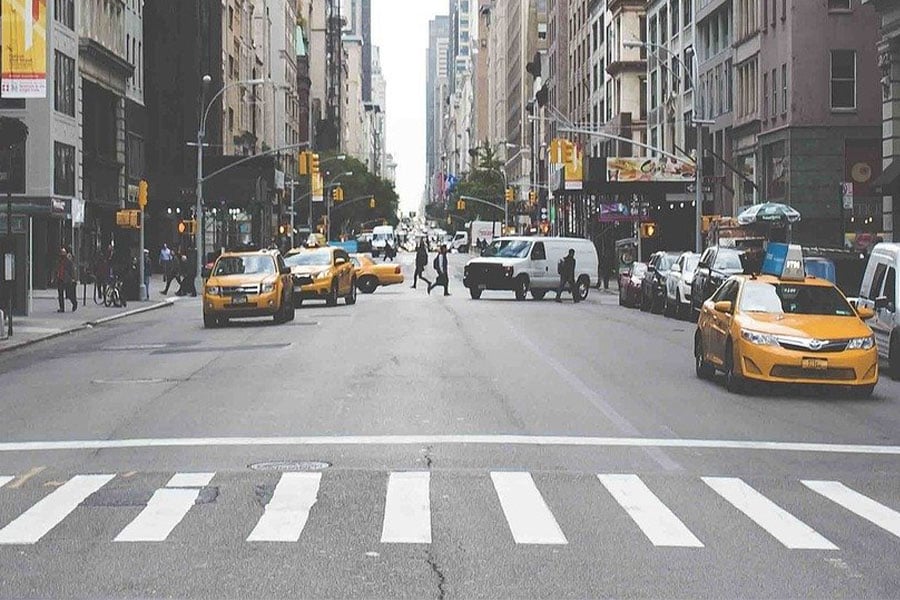Jaywalking 101

For as long as there have been roads, there have been pedestrians that need to cross them. As technology increased over the years, adding wagons, bikes, and eventually automobiles, scooters, and motorcycles to the roadways, the likelihood if injury to foot traffic increased as well. Because of the inherent danger surrounding roadways, systems have been put into place over the years to protect pedestrians and motorists alike.
How did Jaywalking get its name?
According to the Merriam-Webster Dictionary, the term jaywalker was coined in imitation of a slightly older term: jay-driver. Jay-drivers were first mentioned in an article published in the Junction City Union (Junction City, Kansas) in June of 1905. The term initially referred to a driver of a horse-drawn carriage or automobile who refused to abide by the traffic laws, by driving on the wrong side of the road. In October of that same year the Kansas City Star mentioned the pedestrian version of these drivers, the jay walker, who refused to follow sidewalk etiquette by walking on the wrong side of the sidewalk, causing collisions. Though the Kansas City Star article solely scolded people who had poor sidewalk etiquette, it eventually evolved to a term used to describe people who didn’t follow the rules for crossing the street while the term jay-driver mostly vanished from the English vernacular as enforcement for driving became stricter.
If you are still wondering why the “jay” part if this word makes sense, you aren’t alone—and no, a guy named Jay wasn’t the first to misbehave and disregard etiquette. The Merriam-Webster Dictionary defines ‘jay’ as meaning “a greenhorn or rube.” In case that definition didn’t help you, we will dig a little deeper. Greenhorn is a term used for an inexperienced or naïve person, or a newcomer (as to a country) who is unacquainted with local manners and customs, and a rube is an awkward or unsophisticated person. By adding ‘jay’ to –driver and –walker, you were insinuating that the offending person is either inexperienced, naïve, or a newcomer who doesn’t understand the customs.
Is Jaywalking illegal?
Imagine you are in a rush and don’t want to head over to the nearest crosswalk to cross the street. The store you need to visit is directly across from you and there isn’t an intersection in sight. Traffic is light, so you think, “who really cares?” After checking both ways to make sure the traffic is clear, you cross.
Because you chose to cross the street somewhere other than in intersection or crosswalk, you have just jaywalked, and likely participated in an illegal activity by doing so. In the technical sense of the word today, jaywalking specifically refers to a violation of pedestrian traffic regulations and laws (such as crossing somewhere other than a crosswalk or intersection) and is therefore illegal.
But why is it illegal to cross the street mid-block?
While crossing mid-block is not illegal worldwide, it is illegal in the United States due to the high injury and death rates. According to the National Highway Traffic Safety administration’s (NHTSA) most recent data, there were 6,283 pedestrians killed in traffic crashes in 2018 alone. While pedestrians are only involved in 3 percent of traffic incidents, they account for 14 percent of all traffic deaths. Additionally, 70 percent of pedestrian fatalities occur outside of intersections, or when pedestrians are jaywalking.
Don’t Pedestrians always have the right-of-way?
Contrary to popular belief, pedestrians don’t always have the right of way, even in a crosswalk. According to MN Statute 169.21, if a pedestrian crosses a road somewhere other than within a marked crosswalk or an intersection with no marked crosswalk, they have to yield the right-of-way to all vehicles on the roadway. Additionally, pedestrians aren’t supposed to walk if the “don’t walk” sign is on or if there is no reasonable way the vehicle can stop for you, even if the pedestrian is at a marked crosswalk or intersection.
That said, motorists must yield right-of-way to pedestrians who are in marked crosswalks or at an intersection, even if it isn’t marked. If a pedestrian is in a roadway, even if they are in the wrong, motorists must do everything within their power to stop and avoid the collision. One of the Minnesota Pedestrian safety campaign’s utilizes the phrase “every corner, every time,” reminding motorists that pedestrians can cross at any intersection, regardless of if there is a sign, signal, crosswalk, or not, but an even stronger campaign utilized in the seven-county metro is “pedestrian safety is a two-way street,” which empowers both the driver and pedestrian to follow the rules of the road and keep pedestrians safe.
Did you know: 6-9 p.m. is the time period with highest percent of pedestrian fatalities at 26 percent. This is because it is late enough for driving and working adults to be off work, but early enough for people to be out and about.





